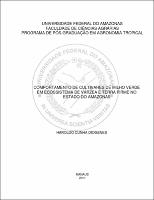| ???jsp.display-item.social.title??? |


|
Please use this identifier to cite or link to this item:
https://tede.ufam.edu.br/handle/tede/2732| ???metadata.dc.type???: | Dissertação |
| Title: | Comportamento de cultivares de milho verde em ecossistema de várzea e terra firme no estado do Amazonas. |
| Other Titles: | BEHAVIOR CULTIVARS GREEN CORN IN ECOSYSTEM OF LAND AND LOWLAND FIRM IN THE STATE OF AMAZON |
| ???metadata.dc.creator???: | Diógenes, Haroldo Cunha  |
| ???metadata.dc.contributor.advisor1???: | Gonçalves, José Ricardo Pupo |
| ???metadata.dc.description.resumo???: | O trabalho objetivou avaliar o comportamento de oito cultivares de milho com características para consumo no estádio verde de maturação e verificar a adaptabilidade aos ecossistemas de terra firme e várzea nas condições edafoclimáticas dos municípios de Manaus e Iranduba no Estado do Amazonas. Os experimentos foram conduzidos no delineamento experimental de blocos casualizados com arranjo fatorial 8 x 2 x 5 e quatro repetições. Os tratamentos foram definidos por oito cultivares de milho, em dois ecossistemas e cinco épocas de colheita realizadas em diferentes estádios de maturação. Foram avaliadas variáveis de aspectos agronômicos e organolépticos, bem como aspectos de características mercadológicas. Os dados foram submetidos à análise de variância e as médias dos tratamentos comparadas pelo teste de Duncan a 5% de probabilidade. Em terra firme e várzea, as cultivares não apresentou diferenças significativas pelo teste F a 5% de probabilidade, quanto à produtividade. O estande de plantas apresentou-se maior na variedade (BR 5110) 56.875 pl ha-1 e menor no híbrido (HTMV1) 43.611 pl ha-1 em terra firme. Na várzea o híbrido (HTMV1) apresentou o menor estande com 47.709 pl ha-1 e a variedade (BR 5110) o maior estande com 72.292 pl ha-1. O comprimento das espigas diferiu estatisticamente pelo teste F a 5% de probabilidade em terra firme, sendo as variedades (Saracura e Cativerde) com maior e menor comprimento 17,81 e 16,09 cm, respectivamente. O número de espigas comerciais foi significativo pelo teste F a 5% de probabilidade em terra firme, sendo que os híbridos (AG 1051 e HTMV1) apresentaram os maiores e menores números de espigas 42.708 e 34.167, respectivamente. Na várzea, os resultados não diferiram pelo teste F a 5% de probabilidade, quanto à doçura e textura. Quanto ao brix, a maciez, o sabor e a coloração diferiram estatisticamente pelo teste F a 5% de probabilidade. Em terra firme, os resultados diferiram estatisticamente quanto ao brix e a coloração. O milho verde é uma ótima opção de cultivo para o Estado do Amazonas, podendo ser cultivado em ecossistemas de várzea e terra firme, com opções de uso de variedades e híbridos de acordo com o nível tecnológico do agricultor. |
| Abstract: | The study aimed to evaluate the performance of eight maize cultivars with characteristics for consumption on the green stage of maturation and verify the adaptability of upland ecosystems and wetlands in the environmental conditions of the cities of Manaus and Iranduba in Amazonas State. The experiments were conducted in a randomized complete block design with factorial arrangement 2 x 8 x 5 and four replications. The treatments were defined by eight maize varieties in two ecosystems and five harvest times during different stages of maturation. Variables were evaluated for agronomic and sensory characteristics as well as aspects of marketing. Data were subjected to analysis of variance and means were compared by Duncan test at 5% probability. In upland and lowland cultivars was no significant difference by F test at 5% probability, for productivity. The plant stand is presented in greater variety (BR 5110) 56875 pl ha-1 and lower in the hybrid (HTMV1) 43,611 pl ha-1 on land. In the lowland hybrid (HTMV1) had the lowest stand with 47,709 pl ha-1 and variety (BR 5110) with the largest booth 72,292 pl ha-1. The length of the spikes differed statistically by F test at 5% probability on firm ground, and the varieties (and Saracura Cativerde) at greater length 17.81 cm and 16.09, respectively. The number of commercial ears was significant by F test at 5% probability on firm ground, and the hybrids (AG 1051 and HTMV1) had the highest and lowest numbers of spikes 42,708 and 34,167, respectively. Floodplain, the results did not differ by F test at 5% probability, as the sweetness and texture. As for brix, tenderness, flavor and color differ statistically by F test at 5% probability. On land, the results were statistically different as to color and brix. The corn is an excellent crop for the state of Amazonas, which can be grown in lowland ecosystems and land, with options to use varieties and hybrids according to the technological level of the farmer. |
| Keywords: | Zea mays Genótipos Cultivares de milho verde Amazonas. Zea mays Corn Genotypes Amazonas. |
| ???metadata.dc.subject.cnpq???: | CIÊNCIAS AGRÁRIAS: AGRONOMIA |
| Language: | por |
| ???metadata.dc.publisher.country???: | BR |
| Publisher: | Universidade Federal do Amazonas |
| ???metadata.dc.publisher.initials???: | UFAM |
| ???metadata.dc.publisher.department???: | Faculdade de Ciências Agrárias |
| ???metadata.dc.publisher.program???: | Programa de Pós-graduação em Agronomia Tropical |
| Citation: | DIÓGENES, Haroldo Cunha. BEHAVIOR CULTIVARS GREEN CORN IN ECOSYSTEM OF LAND AND LOWLAND FIRM IN THE STATE OF AMAZON. 2011. 109 f. Dissertação (Mestrado em Agronomia Tropical) - Universidade Federal do Amazonas, Manaus, 2011. |
| ???metadata.dc.rights???: | Acesso Aberto |
| URI: | http://tede.ufam.edu.br/handle/tede/2732 |
| Issue Date: | 20-Jan-2011 |
| Appears in Collections: | Mestrado em Agronomia Tropical |
Files in This Item:
| File | Description | Size | Format | |
|---|---|---|---|---|
| Dissertacao Haroldo.pdf | 2.6 MB | Adobe PDF |  Download/Open Preview |
Items in DSpace are protected by copyright, with all rights reserved, unless otherwise indicated.




